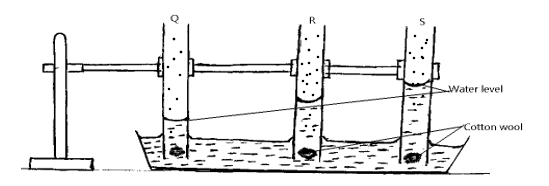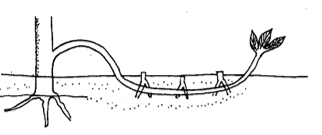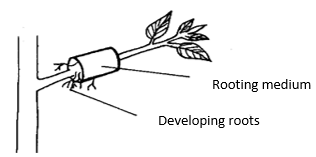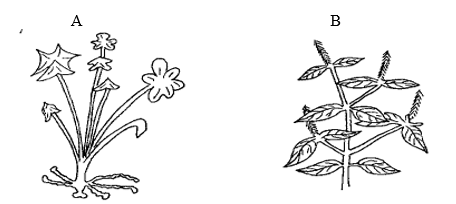INSTRUCTIONS
- This paper contains three sections
- Answer all question in section A and B
- In section C answer any two questions
- Candidates must answer all the questions in English

QUESTIONS
SECTION A 30 MARKS.ANSWER ALL QUESTION
- Name four methods of farming. (2marks)
- State two crop production practices that can be carried out to maintain optimum plant population. (1mark)
- What is a micro catchment? (1mark)
- State any four details contained in a delivery note. (2marks)
-
- What is meant by the term Agroforestry? (1mark)
- State four ways in which land reform can be implemented in kenya (2marks)
- State two examples for each of the following types of cost incurred in poultry production
- variable cost (1marks)
- Fixed cost (1 mark)
- Name three sources of underground water (1½marks)
- State three causes of blossom end of rot in tomatoes (1½marks)
- Give four qualities of a good green manuring plant (2marks)
- State two pests that attack cabbages (1 mark)
- Distinguish between pinching out and coppicing as used in crop production (2marks)
- State four advantages of growing maize in rows instead of broadcasting. (2marks)
- What is integrated pest management (1mark)
- Name four types of water pumps which can be used in the farm. (2marks)
- Name four factors that influence soil erosion. (2marks)
-
- List four problems associated with nomadic pastoralism in Kenya. (2marks)
- Name four factors of production in agriculture. (2marks)
SECTION B 20 MARKS (ANSWER ALL QUESTION)
- The table below shows the population and gross domestic products of countries A and B
Country
Gross Domestic product (million Ksh)
Population (million)
A
1800
36
B
1200
15
- Calculate the per capita income for each country show your working (2marks)
- Which of the two countries is more developed economically (1mark)
- Give a reason for your answer in (b) above (1mark)
- How can agriculture increase the gross domestic product of a country (1mark)
- The diagram below shows an experiment set up using soil type Q, R and S and the observations made after 24 hours. Study the diagram below and answer the questions that follow.

- The experiment set up above is designed to study what? (1mark)
- Name the soil types S and Q (2marks)
S……………………………………………………………………………………………………
Q………………………………………………………………………………………………… - What are the characteristic texture of soil type R and S?
R …………………………………………………………………………………….… (1 mark)
S ………………………………………………………………………………………...(1 mark)
-
- Identify two methods of plucking table formation in tea establishment (2marks)
- Diagram below show crop production practices. Study and answer question that follow.
A

B
- Identify the crop propagation methods illustrated above
A………………………………………………………… (1 mark)
B………………………………………………………………. (1 mark) - State one factors that would promote root formation in the propagation method in a (B) above (1mark)
- Identify the crop propagation methods illustrated above
- The diagram below show weeds. Study them and answer question that follow.
- Identify the weeds illustrated in diagrams A and B (2marks)

A………………………………………………………………………………………………..
B……………………………………………………………………………………………….. - State one reason why the weed labeled A is difficult to control. (1mark)
- State two economic importance of the weed labeled B in Agriculture. (2marks)
- Identify the weeds illustrated in diagrams A and B (2marks)
SECTION C 40 MARKS. (ANSWER ONLY TWO QUESTIONS)
-
- Explain four physical methods of pest control (8 marks)
- Outline five importance of draining agricultural land. (5 marks)
- Explain seven safety precautions observed when spraying herbicides. (7 marks)
-
- Describe the characteristics of ideal agroforestry tree species (8 marks)
- State four factors that influence the type of irrigation to be used in a farm. (4 marks)
- Outline four advantages of rotational grazing (4 marks)
- State four principles governing formation of cooperatives (4 marks)
-
- Describe five ways through which soil loses fertility (10 marks)
- Describe field production of Nappier elephant grass under the following sub heading
- Seed bed preparation (6 marks)
- Utilization (4 marks)

MARKING SCHEME.
- Name four methods of farming. (4 x ½= 2marks)
- Mixed farming
- Agroforestry
- Nomadic pastrolism
- Organic farming
- Shifting cultivation
- State two crop production practices that can be carried out to maintain optimum plant population (2 x ½=1 mark)
- Gapping
- Thinning
- What is a micro catchment? (1mark)
- It’s defined as micro- environment’s which is designed in such a way that aim at conserving soil and water around growing crop.
- State any four details contained in a delivery note. (4 x ½= 2marks)
- Date of delivery
- Quantity and type of good delivered
- Method of delivery
- Person who received the good
- Condition in which goods are received
- Delivery note serial number
-
- What is meant by the term Agroforestry? (1mark)
A variety of land use practices that combine tree growing, pasture and crop production practices on the same piece land for purpose of increasing or improving the soil output. - State four ways in which land reform can implemented in kenya. (4x½ = 2marks)
- Land consolidation
- Land adjudication and registration
- Land settlement and resettlement
- Tenancy reform
- Land subdivision
- Land redistribution
- What is meant by the term Agroforestry? (1mark)
- State two examples for each of following types of cost incurred in poultry production
- variable cost ( 2x½ = 1 marks)
- Cost of feeds
- Cost of drugs
- Fixed cost ( 2x½ = 1 marks)
- Cost of feeder and waterers
- Cost of structures
- variable cost ( 2x½ = 1 marks)
- Sources of underground water (3x½ = 1 ½ marks)
- Springs
- Boreholes
- Wells
- Causes of blossom end of rot in tomatoes (3x½ = 1 ½ marks)
- Irregular watering
- Lack of calcium
- Excessive use of nitrogen
- Qualities of a good green manuring plant (4x½ = 2 marks)
- Hardy – that is growing in poor condition
- Fast growth rate
- Ability to rot quickly
- Highly leafy/ vegetative
- Leguminous high nitrogen content
- State pest attack cabbage (2 x ½ = 1 marks)
- cutworm
- Aphids
- Diamond back moth
- Sawfly
- Nematodes
- Distinguish between pinching out and coppicing as used in crop production (2mark) mark as a whole.
- Pinching out is removal of terminal bud of a shoot while coppicing is the cutting back of young plants at certain point to stimulate growth.
- State four advantages of growing maize in a row instead of broadcasting. ( 4 x ½= 2marks)
- Machine can be used easily between the rows
- Easy to establish the correct plant population
- Lower seed rate is used than in broadcasting
- Easy to carry cultural practice eg weeding, spraying and harvesting
- what is integrated pest management (1mark)
- Is a pest control method that combines both cultural and chemical control method
- Name four types of water pump can be used in farm 4 x ½= 2marks
- Hydram pump
- Semi rotary pump
- Centrifugal pump/ rotary dynamic
- Piston pump / reciprocating pump
- Name four factors that influence soil erosion. (4 x ½= 2marks)
- Topography of land / slope
- Rainfall intensity /amount
- Overstocking
- Clean weeding
- Type of soil
- Vegetation cover
- Deforestation
- Planting annual crops
- Soil depth
-
- List four problems associated with nomadic pastoralism in Kenya. (4 x ½= 2marks)
- Livestock parasites and diseases due to communal watering points, grazing and spraying points.
- Tendency of increased soil erosion and land degradation.
- Difficult to control breeding and breeding diseases.
- Low production of both meat, milk and hides/ skins due to energy losses.
- Conflict and ethnic tension among the nomadic communities for control of good pastures and water.
- four factor of production (4 x ½= 2marks)
- Land
- Labour
- Capital
- Management (Entrepreneurship)
- List four problems associated with nomadic pastoralism in Kenya. (4 x ½= 2marks)
SECTION B 20 MARKS. ANSWER ALL QUESTION
- The table below shows the population and gross domestic products of countries A and B
Country
Gross Domestic product (million Ksh)
Population (million)
A
1800
36
B
1200
15
- Calculate the per capita income for each country show your working (2marks)
Calculation of per capital income
Per capita income = (Gross Domestic product)/population
A = 1800/36=50
B = 1200/15=80 - Which of the two countries is more developed economically (1mark)
B - Give a reason for your answer in (b) above (1mark)
B has a higher per capita income - How can agriculture increase the gross domestic product of a country (1mark)
By creating employment/ developing industries/ increasing production.
- Calculate the per capita income for each country show your working (2marks)
- The diagram below shows an experiment set up using soil type Q,R and S and observations made after 24 hours. Study the diagram below and answer the questions that follow.
- The experiment set up above is designed to study what? (1mark)
Soil water capillarity. - Name the soil types S and Q (2marks)
S Clayey soil
Q sand soil - What is the characteristic texture of soil type R and S?
R Moderately textured (1mark)
S fine textured (1mark)
- The experiment set up above is designed to study what? (1mark)
-
- Methods of plucking table formation in tea (2x1=2marks)
- Formative pruning
- Pegging
- Identify the crop propagation methods illustrated above (2x1=2 marks)
- A Trench layering
- B Aerial/ marcotting layering
- One factors that would promote root formation in the propagation method in a (B) above (1mark)
- Availability of moisture
- Treatment and application of auxins (hormones)
- Availability of oxygen
- Use of proper propagation technique to ensure better healing of wound/ keeping rooting medium in contact with the stem.
- Identify the crop propagation methods illustrated above (2x1=2 marks)
- Methods of plucking table formation in tea (2x1=2marks)
-
- Identify the weeds illustrated in diagrams A and B (2x1=2marks)
- A- Oxalis
- B – Devils Horse Whip
- State one reason why the weed labeled A is difficult to control. (1mark)
- has underground storage structures/ tuber that regenerate easily
- State two economic importance of the weed labeled B in Agriculture. (2x1=2marks)
- It’s a weed in annual crops (competition for nutrient)
- it irritates farm workers reducing their efficiency
- increase the cost of production when controlling weed
- Reduce the quality of wool in sheep.
- Identify the weeds illustrated in diagrams A and B (2x1=2marks)
SECTION C 40 MARKS
-
- Explain four physical methods of pest control (4x2=8marks)
- Use of lethal temperature – These are too hot or too cold conditions which kill pests.
- Proper drying of produce – drying of grains makes them too hard for pests to penetrate.
- Flooding – drowns underground pests eg moles and cutworms.
- Suffocation – pumping carbon(IV) oxide into hermetic Cyprus bins deprives pests of oxygen.
- Physical destruction – done through trapping, hand picking and killing them.
- Use of scare crows/ devices – for scaring large animals and birds from crop fields.
- Use of physical barriers – Barriers such as trenches fences, rat guards prevent pests from getting into crop fields or stores.
- Use of electromagnetic radiation – electromagnetic radiations are used to kill insect pests through deactivation of enzymes
x 2 = 8marks)(Method – 1mark, Explanation – 1mark)
- Outline five importance of draining agricultural land. (5x1=5 marks)
- It facilities leaching of harmful minerals
- Improves aeration of the soil
- Raises the soil temperature
- Increases activity of micro-organisms in the soil due to improved aeration
- Reduces the run-off water thus lowering the rate of soil erosion
- Increases the soil volume
- Reduces incidences of livestock diseases such as foot rot
- Explain seven safety precautions observed when spraying herbicides. (7x1=7 marks)
- Wear protective clothing such as gloves overalls and boots
- Avoid inhaling herbicides by not smoking while spraying
- Read manufacturer’s instructions and following them strictly
- Avoid sucking blocked nozzles
- Wash thoroughly immediately after handling the herbicides
- Keep the herbicides safely out of reach of children
- Do not wash the equipment used for herbicides in water sources
- Avoid chemical spillage in water sources
- Avoid handling food before washing
- Explain four physical methods of pest control (4x2=8marks)
-
- Describe the characteristics of ideal agroforestry tree species (4x2=8marks)
- Nitrogen fixing ability – The trees should be preferably legumes. They should be capable of fixing Nitrogen into the soil for use by other crops;
- Fast growing ability – trees chosen should be fast growing and early maturing so that they can be put into other uses – thus should have a high biomass production e.g fuel wood
- Multipurpose nature – the chosen trees should be able to meet other uses such as provision of fuel woods, fodder, poles and timber.
- By – product production – The best agroforestry tree species should be able to
produce economic products and by-products which can be used or sold for income e.g
those producing edible leaves, fruits, medicinal products, poles and fodder. - Deep rooted with a narrow root zone – when agro-forestry trees have deep roots, they acquire their nutrients from lower soil horizons where most plant roots do not reach-hence minimal competition for nutrients;
- Non-competitive ability with main crop- a good agroforestry tree species should not compete with the main crops for light and nutrients unnecessarily.
- Nutritious and palatable – trees used for this purpose should be both nutritious and palatable as leaf fodder for livestock use.
- Easily coppiced – the trees species which will be able to regenerate after cutting back for pruning are preferred.
(4 x 2 = 8marks)(Characteristic – 1mark, explaination – 1mark)
- State four factors influence the type of irrigation to be used in a farm (4x1=4 marks)
- Topography of the land
- Soil type
- Type of crop to be irrigated
- Amount of water available
- Distance of the source of water to the field
- Capital available, skill available
- Climate factors of the area
- four advantages of rotational grazing (4x1=4mark)
- Livestock make maximum use of pasture
- Reduce build up of parasite and diseases
- Animal wastes is distributed evenly in paddock
- Pasture is given time to regrow before its grazed again
- Excess pasture can be harvested for conservation
- Its possible to apply fertilizer in part of pasture which are not in use.
- State the principle of cooperative 4x1=4marks
- Open membership
- Equal right
- Principle of share limit
- Interest on share
- Withdraw from membership
- Loyalty
- Education
- Co-operative principle
- Nonprofit motive
- Describe the characteristics of ideal agroforestry tree species (4x2=8marks)
-
- Ways though which soil loses fertility (5x2= 10 marks)
- Leaching – As water infiltrates into the soil it moves together with dissolved soluble minerals to lower horizon beyond the reach of many plant roots.
- Soil Erosion – Carrying away of top soil rich in nutrients by agents – the fertile soil will be deposited elsewhere
- Monocropping – the crop grown will use the same nutrients till exhausted leaving out other nutrients, remain unused
Continous cropping on the same piece of land over a long period of time exhaust all the nutrients - Burning of the vegetation – burning destroys organic matter leading to destruction of soil structure
- Accumulation of salts that lead to salinity. This change in PH leads to loss of soil fertility
- Change in soil PH – increase or decrease in soil PH as a result of use of different fertilizers affects the activity of soil microorganisms as well as availability of soil nutrients.
(5x 2 = 10marks)(Method – 1mark, Explanation – 1mark)
- Describe field production of Napier elephant grass under the following subheadings
- Seed bed production (5x1=5marks)
- Practice early seedbed preparation /during the dry period
- Clear all the vegetation / stumps
- Carry out primary tillage/ dig deeply to remove all weeds / perennial weeds
- Carry out secondary tillage/ harrow to appropriate medium teeth
- Prepare furrow / holes for planting
- Spacing between furrows 90 – 100 cm for cutting / 90 – 100 cm x 50 cm for splits
- Utilization (5x1= 5marks)
- Cut and feed it to ruminants
- Defoliate / cut at the right stage of growth /3-5 months old when stems are 1-1.5 m high
- Cut the stems at 2.5 -5cm above the ground surface
- Use sharp panga for cutting
- Conserve excess as silage
- Chop napier grass into small pieces before feeding
- Seed bed production (5x1=5marks)
- Ways though which soil loses fertility (5x2= 10 marks)
Download Agriculture Paper 1 Questions and Answers - Nginda Girls Mock Examination 2023.
Tap Here to Download for 50/-
Get on WhatsApp for 50/-
Why download?
- ✔ To read offline at any time.
- ✔ To Print at your convenience
- ✔ Share Easily with Friends / Students
